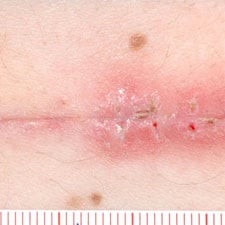It may and will be possible to effectively treat traumatic injuries of pilots on the battlefield by using an innovative light-based method developed by the Office of Scientific Research in the US Air Force.

This innovative treatment for battle injuries includes the use of a process called "Photochemical Tissue Bonding", which is able to replace sutures, staples and adhesives in the healing of skin injuries, in which peripheral nerves, blood vessels, tendons and other tissues are reconnected.
Dr. Irene Kochevar, a professor at Harvard Medical School, and her research colleagues are satisfied with their initial laboratory experiments that led to an experimental medical test.
"We have demonstrated that this method is extremely beneficial in the field of medicine for the Air Force because it yields better healing and functional results than the treatment of these bruises by normal methods," says the researcher.
The process to create the fusion, or the nano-sutures, is carried out by applying a dye to the wound or the damaged tissue and then exposing it to green light for a short time. The dye absorbs the light, which helps it to molecularly connect proteins that are on the surface of the tissue.
"Our method does not use adhesives, proteins or other substances that may encourage an inflammatory reaction," adds the researcher. "An immediate and waterproof seal is obtained between the surfaces of the tissue leading to less inflammation in the near term and the formation of a less prominent scar in the long term."
The researchers intend to continue to evaluate the effectiveness of their innovative method and examine how it can be further improved for the battlefield itself. Right now, they are looking for the conditions to shorten the treatment time and create an even stronger fusion.
"We are approaching this goal by identifying the underlying molecular mechanisms responsible for this radiation-activated cross-linking," said the researcher. "We believe that this information will help us improve the effectiveness and usefulness of the nano-sewing method for the battlefield."

6 תגובות
Boaz (1) You are very right - it is not suitable for pilots - they should transfer it to the navy because it is written that it is waterproof.
According to what I understood, the connection to the pilots is faster healing and return to function than usual.
And more importantly, to the best of my understanding, the ability to move and the flexibility of the "stitched" organ, or rather the lighted one, probably remain almost as good as they were before. Because in the area of the scar, the skin shrinks and somewhat limits the movement. And apparently this bit, interferes a lot in flight.
But………… I could be wrong. That's just what I understood.
Almond:
I guess "sex rooms" is a typo and not a new service in the hospitals 🙂
Besides - if you review the article's list of keywords, you will find plastic medicine among them.
It is worth checking the technology in sex rooms and even in the field of plastic surgery
Exactly what I wanted to ask…
Has anyone been able to figure out what the pilots have to do with it?
Apart from the fact that the American Air Force is testing the method, I did not see any connection.
When pilots are injured by the way...usually, no ointment will help them.